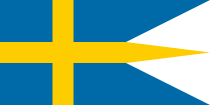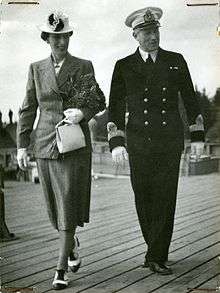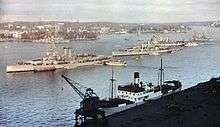Coastal Fleet
| Coastal Fleet | |
|---|---|
| Kustflottan | |
 | |
| Active | 1904–2000 |
| Country | Sweden |
| Allegiance | Swedish Armed Forces |
| Branch | Swedish Navy |
| Type | Naval force composed of surface combatant, minelayer, minehunter and submarine units |
| Role | Naval authority |
| March | "Kustflottans marsch" (Åke Dohlin)[1] |
| Insignia | |
| Naval Ensign |
 |
Coastal Fleet[2] (Swedish: Kustflottan, Kfl) was until 1994 a Swedish Navy authority with the main task of training the naval ships commanders and crews.[3] After the formation of the authority Swedish Armed Forces in 1994, the Coastal Fleet remained as a unit until 2000.
History
The Swedish Navy ships were equipped for expeditions during the summer months and were organized in temporary squadrons under the leadership of the Highest Commander (högste befälhavare). In 1904 an Inspector of the Navy's Exercises at Sea (Inspektör för flottans övningar till sjöss) was also appointed, the highest commander of the coastal squadrons. From 1909 the squadrons began to be called coastal fleets. From 1919, the positions of the Highest Commander and Inspector of the Navy's Exercises at Sea (SFS 1918:868) were merged and the position of the Highest Commander of the Coastal Fleet (Högste befälhavaren för kustflottan) was created, which in turn was changed in 1931 to the Chief of the Coastal Fleet (Chefen för kustflottan).[4]
The command sign of the last Chief of the Coastal Fleet, Frank Rosenius, was lowered on 30 June 1998.[5]
Commanders

Inspector of the Navy's Exercises at Sea
- 1904–1906 – Wilhelm Dyrssen
- 1906–1907 – Carl Olsen
- 1907–1916 – Wilhelm Dyrssen
- 1916–1918 – Carl August Ehrensvärd
Highest Commander of the Coastal Fleet
- 1919–1919 – Carl August Ehrensvärd
- 1919–1923 – Carl Alarik Wachtmeister
- 1923–1925 – Fredrik Riben
- 1926–1927 – Otto Lybeck
- 1927–1931 – Harald Åkermark
Chief of the Coastal Fleet
- 1931–1933 – Harald Åkermark
- 1933–1939 – Fabian Tamm
- 1939–1942 – Gösta Ehrensvärd
- 1942–1945 – Yngve Ekstrand
- 1946–1950 – Erik Samuelson
- 1950–1953 – Stig H:son Ericson
- 1953–1957 – Erik af Klint
- 1957–1961 – Bertil Berthelsson
- 1961–1966 – Einar Blidberg
- 1966–1970 – Dag Arvas
- 1970–1977 – Christer Kierkegaard
- 1977–1980 – Bengt Rasin
- 1980–1982 – Bror Stefenson
- 1982–1985 – Jan Enquist
- 1985–1990 – Claes Tornberg
- 1990–1994 – Sten Swedlund
- 1994–1998 – Frank Rosenius
References
- ↑ Sandberg, Bo (2007). Försvarets marscher och signaler förr och nu: marscher antagna av svenska militära förband, skolor och staber samt igenkännings-, tjänstgörings- och exercissignaler (in Swedish) (New ed.). Stockholm: Militärmusiksamfundet med Svenskt marscharkiv. p. 204. ISBN 978-91-631-8699-8. LIBRIS 10413065.
- ↑ Appich, Jr., Thomas W. (22 July 1988). "REFERENCE AID SWEDISH-ENGLISH GLOSSARY OF MILITARY AND TECHNICAL ACRONYMS AND ABBREVIATIONS" (PDF). Joint Publications Research Service. Foreign Broadcast Information Service. p. 27. Archived from the original (PDF) on 20 February 2017. Retrieved 9 September 2018.
- ↑ "Kustflottan". Nationalencyklopedin (in Swedish). Retrieved 20 October 2017.
- ↑ "Chefen för kustflottan (1875 – )" [Chief of the Coastal Fleet (1875 – )] (in Swedish). National Archives of Sweden. Retrieved 20 October 2017.
- ↑ Jeppsson, Tommy (2009). "Kustflottans historia" [History of the Coastal Fleet] (PDF). Kungl. Krigsvetenskapsakademiens handlingar och tidskrift (in Swedish). Stockholm: Kungl. Krigsvetenskapsakademien (5): 132. LIBRIS 3417415.
Further reading
External links
- Coastal Fleet Officer Association (in Swedish)
